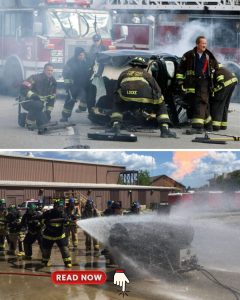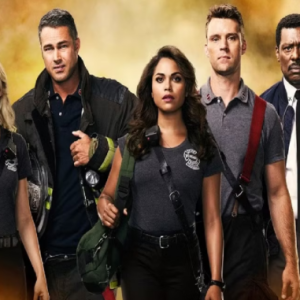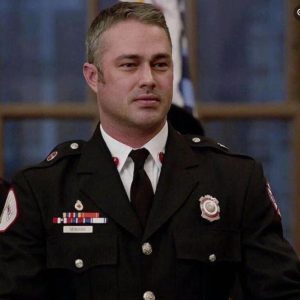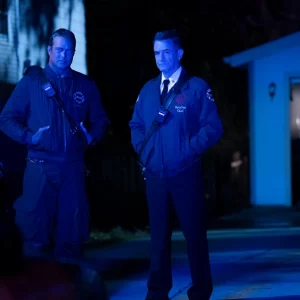Since its inception in 2012, no matter how hot the cast, there’s been only one person
who’s really brought the heat, smoke and flames to “Chicago Fire”: special effects coordinator
and pyrotechnics expert John Milinac. Fire may be the star of Dick Wolf’s scorching series,
but Milinac is its master. For ten seasons, Milinac has taken Chicago’s fictional firefighters and paramedics into battle with raging flames, rapidly enveloping smoke and crumbling properties, as well as exploding cars, out-of-control trucks, unanchored power lines and slippery roofs. Speaking to Variety, while working on the seventh episode of the season, Milinac and his 13-person crew were preparing a “burning stage” and all of its elements to be ready for filming on Tuesday morning.
“It was a huge effort, especially after we had just wrapped up a condensed exterior fire—which meant everything was overlapping—and then we had some carnage with some vehicles, which meant we had to pre-treat some damage.” Along with creating and executing such levels of destruction, “Chicago Fire”-style, Milinac had to talk to almost every lead on set—from the art department to the writers—before he and his crew could get to work. “A lot of the action from one episode often bleeds into another, so that was always in the back of my mind.” Popular on Variety Milinac didn’t just show up on the set of “Chicago Fire” with a torch and a dream.
He got his start in the mechanical special effects department and supervisor for films like 2010’s “A Nightmare on Elm Street” and 2009’s “Friday the 13th” — where fire, snow and rain were crucial to the story. “Personally, it’s a sense of expansion, always learning something new,” he said. “You learn what you can do, period. You learn what fire can do. You take what you’ve learned and show what you can expect to happen. I can tell you more about this…. If we do that.” Milinac said “Chicago Fire” began in the writers’ room, where the team figured out what they wanted for a scene, often based on personal experiences, “awesome, real.” Milinac can then put the ideas into context for his technical and effects team about what is and isn’t possible.

Then there are the conversations about on-camera effects and safety concerns, which top the long list of considerations for each scene. Like any experiment, there’s a lot of trial and error. “We go to locations for most of our exteriors, so we have to treat those exteriors like custom builds with our own selection process for what will and won’t work,” Milinac says. “One location has three windows. Another has ten. Which one works better? Which one might have the city in the background? Which one has another building next to it that we have to protect that asset too? We always keep our eyes open.” You can’t let one aspect get away from you, and if you do, we have to deal with what’s scorched or melted, we’re responsible for it, and we fix it. When we do our sets, it’s a rebuild every week — the next set might not have a fire, but the set after that might have two fires.
Whether it’s inside or outside, after consulting with the art department, the fires of “Chicago Fire” are controlled like a conductor conducting an orchestra: where do they need to be, how long do they burn, how much of the materials used will burn? “Drywall won’t burn, but paper does — we can stay ahead of it,” Milinac said, noting that many of the set’s “products” (like fake televisions or stereo components) are made of steel, so they don’t burn. Fire can be fierce, scary, and epic to watch, but as a medium for film and television, it’s unreliable and fickle. How does Milinac control fire to his liking — and when those plans don’t work, how does digital technology come to the rescue? Fire control comes in part from how the “Chicago Fire” set was built. “Heat is a big metric,” Milinac says. “If you’re building a box, you’re building a furnace, so you have to make sure a crew can stand in there, wearing all the fire-resistant materials with actors in actual firefighting gear, and paying attention to our ‘victims.’
We have to keep the heat out at all times. We’re always on ventilation, with smoke — a legitimate atmosphere — being evacuated. With real fires, you wouldn’t see your hand in front of your face. But for the purposes of telling the story of ‘Chicago Fire,’ we ame, whether it is three or 25 fires, with numbers assigned to every pipe and with everyone — director, camera, DPs — agreeing on what are the perfect levels of value for each pipe and height for each flame.” If something isn’t burning as needed, there are flammable materials to be brushed or pasted on for applying propane (“our primary fuel”). Flicker effects can be used by the lighting apartment to create an illusion of flame near an actor. Editors in post can always add flame at will to a scene. “It has to be sustainable for an actor to be in that space,” Milinac says. “We give them a small amount of fire so that visual effects can expand upon it in post. That doesn’t happen often, but maybe you just want to up a flame 10 additional percent for drama.”





